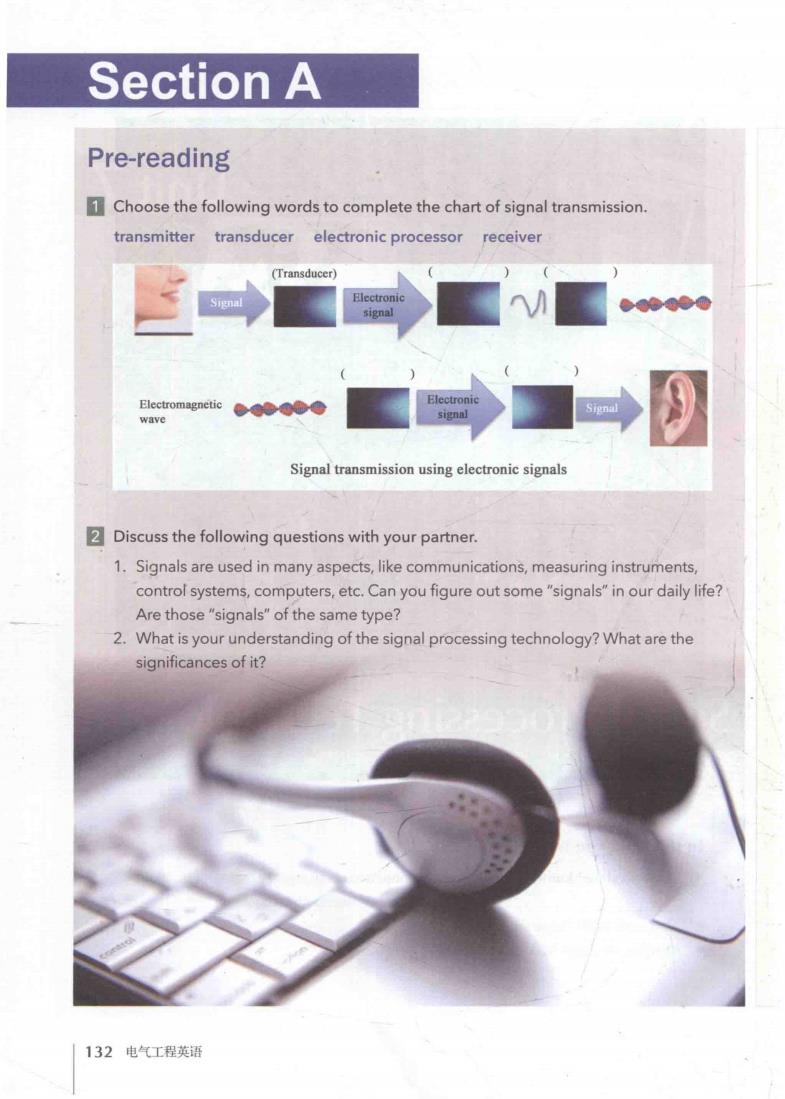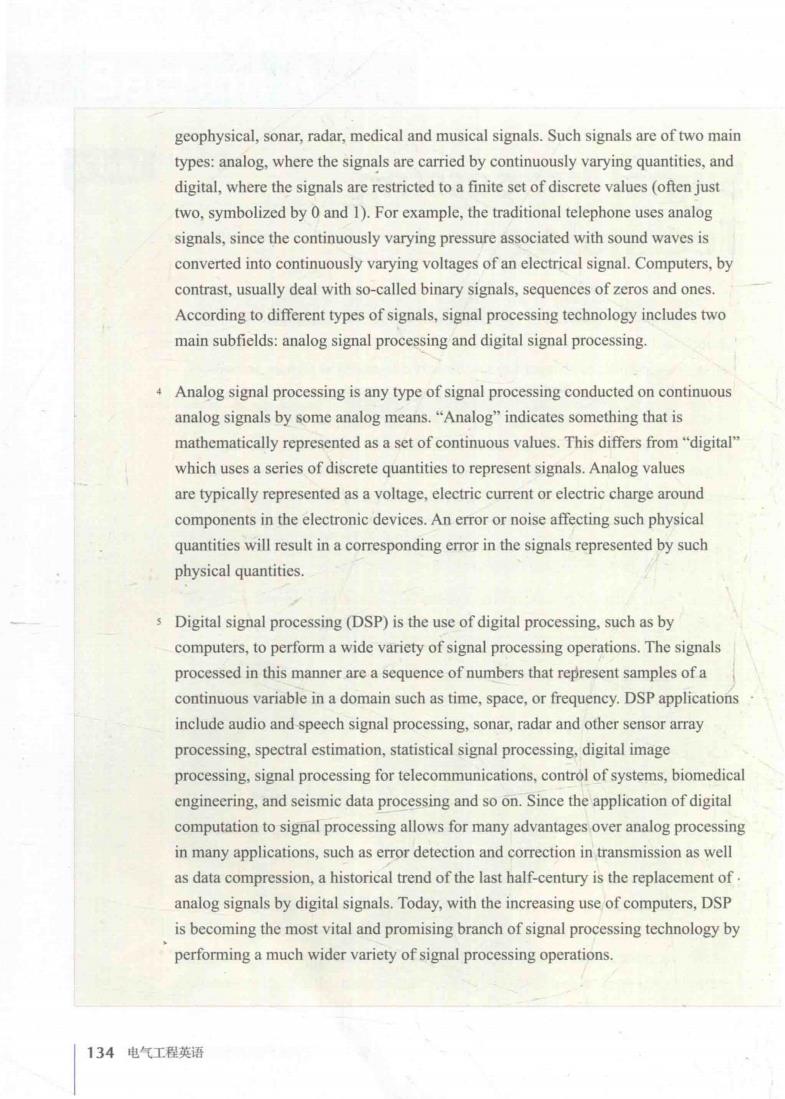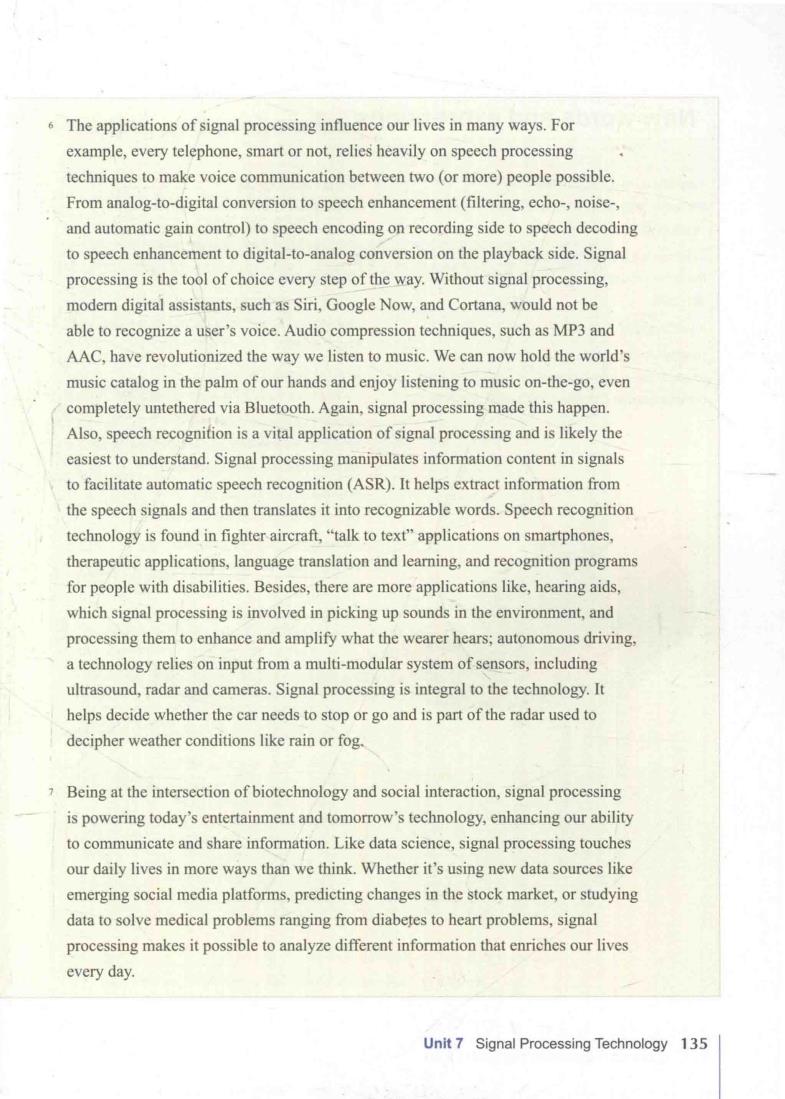
Section A Pre-reading Choose the following words to complete the chart of signal transmission transmitter transducer electronic processor receiver ■→■→ Signal transmission using electronic signals Discuss the following questions with your partner. 1.Signals are used in many aspects,like communications,measuring instruments, control systems,computers,etc.Can you figure out some"signals"in our daily life? Are those"signals"of the same type? 2.What is your understanding of the signal processing technology?What are the significances of it? 132电气工程英语
I SectionA I Pre-reading Choose the following words to complete the chart of signal transmission. transmitter transducer electronic processor receiver Electromagnetic wave ...... Signal transmission using electronic signals Discuss the following questions with your partner. ...... 1. Signals used in many aspec like communications , measuring instruments , control systems, computers, etc. Can you figure out some "signals " in our daily life? Are those "signals" of the same type? 2. What is your understanding of the signal process ing technology? What are the significances of it? 132 电气工程英语

Signal Processing Text A Technology Signal processing.a branch of electrical engineering,is an enabling technology that models and analyzes data representations of information contained in many different physical,symbolic,or abstract formats broadly designated as signals.It involves taking in a signal,from a radio,cell phone,musical instrument,etc.,and parsing it to pull out the relevant information.Specifically,common signal processing operations include the following:amplification to compensate for attenuation,filtering to reduce interference and noise and/or to obtain selected facets of information, equalization to correct some types of distortion,sampling to get a signal that better suits the system characteristics,and multiplexing to permit one transmission system to handle two or more information-bearing signals simultaneously According to Alan V.Oppenheim and Ronald W.Schafer,the principles of signal processing can be found in the classical numerical analysis techniques of the 17th century.Oppenheim and Schafer further state that the"digitalization"or digital refinement of these techniques can be found in the digital control systems of the 1940s and 1950s.It was in the 1960s that a discipline of digital signal processing began to form.At that time digital signals were becoming more common,and advances in microelectronics(the ability to build extremely complex eircuits in a very small space)made it possible to carry out some of the impossible tasks before. A signal as referred to in communication systems,signal processing and electrical engineering is a function that conveys information about the behavior or attributes of some phenomenon.In the physical world,any quantity exhibiting variation in time or variation in space(such as an image)is potentially a signal that might provide information on the status of a physical system,or convey a message between observers,among other possibilities.The IEEE Transactions on signal processing states that the term"signal"includes audio,video,speech,image,communication, Unit 7 Signal Processing Technology 133
Signal · Processing `匹 Technology , 1 Signal processing , a branch of electrical engineering , is an enabling technology that models and analyzes data representations of information contained in many different physical, symbolic , or abstract formats broadly designated as signals. It involves taking in a signal, from a radio, cell phone, musical instrument, etc., and parsing it to , pull out the relevant information. Spec cally common signal processing operations include the following : amplification to compensate for attenuation , filtering to reduce interference and noise and / or to obtain selected facets of information, equalization to correct some types of distortion, sampling to get a signal that better suits the system characteristics , and multiplexing to permit one transmission system to handle two or more information-bearing signals simultaneously. 2 According to Alan V. Oppenheim and Ronald W. Schafer, the principles of signal processing can be found in the classical numerical analysis techniques of the 17th century. Oppenheim and Schafer further state that the "digitalization" or digital refinement of these techniques can be found in the digital control systems of the 1940s and 1950s. It was in the 1960s that a discipline of digital signal processing began to form. At that time digital signals were becoming more common, and advances in microelectronics (the ability to build extremely complex circuits in a very small space) made it possible to carry out some of the impossible tasks before. J A signal as referred to in comm 1ication systems, signal processing and electrical engineering is a function that conveys inf orrnation about the behavior or attributes of some phenomenon. In the physical world , any quantity exhibiting variation in time or variation in space (such as an image) is potentially a signal that might provide information on the status of a physical system, or convey a message between observers , among other possibilities. The IEEE Transactions on signal processing states that the term "signal " includes audio , video , speech , image, communication , Unit 7 Signal Processing Technology 133

geophysical,sonar,radar,medical and musical signals.Such signals are of two main types:analog,where the signals are carried by continuously varying quantities,and digital,where the signals are restricted to a finite set of discrete values(often just two,symbolized by 0 and 1).For example,the traditional telephone uses analog signals,since the continuously varying pressure associated with sound waves is converted into continuously varying voltages of an electrical signal.Computers,by contrast,usually deal with so-called binary signals,sequences of zeros and ones. According to different types of signals,signal processing technology includes two main subfields:analog signal processing and digital signal processing. 4 Analog signal processing is any type of signal processing conducted on continuous analog signals by some analog means."Analog"indicates something that is mathematically represented as a set of continuous values.This differs from"digital" which uses a series of discrete quantities to represent signals.Analog values are typically represented as a voltage,electric current or electric charge around components in the electronic devices.An error or noise affecting such physical quantities will result in a corresponding error in the signals represented by such physical quantities. Digital signal processing(DSP)is the use of digital processing.such as by computers,to perform a wide variety of signal processing operations.The signals processed in this manner are a sequence of numbers that represent samples of a continuous variable in a domain such as time,space,or frequency.DSP applications include audio and speech signal processing,sonar,radar and other sensor array processing.spectral estimation,statistical signal processing.digital image processing,signal processing for telecommunications,control of systems,biomedical engineering,and seismic data processing and so on.Since the application of digital computation to signal processing allows for many advantages over analog processing in many applications,such as error detection and correction in transmission as well as data compression,a historical trend of the last half-century is the replacement of analog signals by digital signals.Today,with the increasing use of computers,DSP is becoming the most vital and promising branch of signal processing technology by performing a much wider variety of signal processing operations. 134电气工程英语
geophysical, sonar, radar, medical and musical signals. Such signals are of two main types: analog, where the sign~ls are carried by continuously varying quantities, and digital, where the signals are restricted to a finite set of discrete values (often just two, symbolized by O and 1). For example, the traditional telephone uses analog signals, since the continuously varying pressure associated with sound waves is converted into continuously varying voltages of an electrical signal. Computers, by contrast, usually deal with so-called bina signals sequences of zeros and ones. According to erent types of signals, signal processing technology includes two main subfields: analog signal proces~ing and digital signal processing. 4 Analog signal processing is any type of signal processing conducted on continuous analog signals by some analog means. "Analog" indicates something that is mathematically represented as a set of continuous values. This differs from "digital " which uses a series of discrete quantities to represent signals. Analog values are typically represented as a voltage , electric current or electric charge around components in the electronic devices. An error or noise affecting such physical quantities will result in a corresponding error i.J1 the signals represented by such physical quantities. s Digital signal processing(DSP) is the use of digital processing , such as by computers, to perform a wide variety of signal processing operations . The signals processed in this manner are a sequence of numbers that represent samples of a continuous variable in a domain such as tirne, space, or frequency. DSP applications include audio and speech signal processing, sonar, radar and other sensor array processing, spectral estimation , st stical signal processing , digital irnage processing, signal processing for telecommunications, control of systems, biomedical en neering and seismic data processing and so on. Since the application of digital computation to signal processing allows for many advantages over analog processing in many applications , such as error detection and correction in transmission as well as data compression , a historical trend of the last half-century is the replacement of • analog signals by digital signals. Today, with the increasing use of computers, DSP is becoming the most vital and promising branch of signal processing technology by performing a much wider variety of signal processing operations. 134 电气工程英语

.The applications of signal processing influence our lives in many ways.For example,every telephone,smart or not,relies heavily on speech processing techniques to make voice communication between two (or more)people possible From analog-to-digital conversion to speech enhancement(filtering,echo-,noise- and automatic gain control)to speech encoding on recording side to speech decoding to speech enhancement to digital-to-analog conversion on the playback side.Signal processing is the tool of choice every step of the way.Without signal processing. modern digital assistants,such as Siri.Google Now,and Cortana,would not be able to recognize a user's voice.Audio compression techniques,such as MP3 and AAC,have revolutionized the way we listen to music.We can now hold the world's music catalog in the palm of our hands and enjoy listening to music on-the-go,even completely untethered via Bluetooth.Again,signal processing made this happen. Also,speech recognition is a vital application of signal processing and is likely the easiest to understand.Signal processing manipulates information content in signals to facilitate automatic speech recognition(ASR).It helps extract information from the speech signals and then translates it into recognizable words.Speech recognition technology is found in fighter aircraft,"talk to text"applications on smartphones, therapeutic applications,language translation and learning,and recognition programs for people with disabilities.Besides,there are more applications like,hearing aids, which signal processing is involved in picking up sounds in the environment,and processing them to enhance and amplify what the wearer hears;autonomous driving. a technology relies on input from a multi-modular system of sensors,including ultrasound,radar and cameras.Signal processing is integral to the technology.It helps decide whether the car needs to stop or go and is part of the radar used to decipher weather conditions like rain or fog. Being at the intersection of biotechnology and social interaction,signal processing is powering today's entertainment and tomorrow's technology,enhancing our ability to communicate and share information.Like data science,signal processing touches our daily lives in more ways than we think.Whether it's using new data sources like emerging social media platforms,predicting changes in the stock market,or studying data to solve medical problems ranging from diabetes to heart problems,signal processing makes it possible to analyze different information that enriches our lives every day. Unit 7 Signal Processing Technology 135
6 The applica ns of signal processing influence our lives in many ways. For example , every telephone, smart or not, relies heavily on speech processing techniques to make voice communication between two (or more) people possible. From analog-to-digital conversion to speech enhancement (filtering, echo-, noise-, and automatic gain control) to speech encoding on recording side to speech decocling to speech enhancement to gital-to-analog conversion on the playback side. Signal processing is the tool of choice eve1y step of the Without signal processing, modern digital assistants , such a:s Siri, Google Now, and Cortana, would not be able to reco ize a user's voice. Audio compression techniques, such as MP3 and AAC, have revolutionized the way we listen to music. We can now hold the world's music catalog in the palm of our bands and enjoy tening to music on-the-go, even completely untethered via Bluetootb . Again , signal processing made this happen. Also, speech recognition is a vital application of signal processing and is likely the easiest to understand. Signal processing manipulates information content in signals to facilitate automatic speech reco ition (ASR). It helps extract information from th.espeech signals and then translates it into reco izable words. Speech recognition technology is found in fighter aircraft, "talk to text" applications on smartphones, therapeutic applications , language translation and learning , and reco ition programs for people with sab ties. Besides, there are more applications like, hearing aids, which signal processing is involved in pic up sounds in the envirorunent, and processing them to enhance and amplify what the wearer hears; autonomous driving, a technology relies on input from a multi-modular system of sensors, inclu ng ultrasound, radar and cameras. Signal processing is integral to the technology. It helps decide whether the car needs to stop or go and is part of the radar used to decipher weather conclitions like rain or fog 1 Being at the intersection of biotechnology and social interaction , sigirnl processing is powering today's entertainment and tomorrow's technology , enhancing our ability to communicate and share information. Like data science , signal processing touches our daily lives in more ways tl1an we think. Whether it's using new data sources like emerging social media platforms , predicting changes in the stock market , or studying data to solve medical problems ranging from diabetes to heart problems , signal processing makes it possible to analyze different information that enriches our lives every day. Unit 7 Signal Processing Technology 135

New words and expressions amplification /,aemplifr'keifon/n. analog /'aenolog/adj. the act or process of making sth.larger,greater,or using signals or information represented by stronger放大(率) continuously changing quantities of space, attenuation /a,tenjo'eifan/n. electrical current,etc.类似的:模拟的 the act or process of making sth.weaker or less binary /'bainori/adj. 减:衰弱 relating to a system of counting,used in equalization/,i:kwalar'zeifon/n.均衡 computers,in which only the numbers 0 and lare used二进制的 multiplex /'mAltipleks/vi. to send two or more messages or signals along a spectral /'spektral/adj. communication channel at the same time多路传输 relating to or made by a spectrum光谱的 seismic /'saizmik/adj. subject to or caused by an earthquake or earth vibration地震的:因地震而引起的 untethered /,An'teoad/adj. not confined or restricted不受限制的 therapeutic /,0era'pju:tik/adj. tending to cure or restore to health治疗的;治疗 学的 autonomous /:'tonamas/adj. existing as an independent entity自主的 multi-modular/,mAltr'mpd3ula(r)/ad.多模块 化的 decipher/dr'sarfa(r)/vt. to convert code into ordinary language译解;解释 diabetes/,dal3'bi:ti:zn.糖尿病 EEE Transaetions美国电气与电子工程协会会刊 136电气工程英语
[ Newwords and expressions J amplification ,印mplrf1'ke1Jan/ n the act or process of making sth. larger, greater, or stronger 放大(率) attenuation /a,tenju'e1Jan/ n. the act or process of making sth. weaker or less 减;衰弱 equalization /,i:kwala1'ze1Jan/ 均衡 multiple, /1mA.lt1pleks/ vi. to send two or more messages or signals along a communication channel at the same time 多路传输 136 电气工程英语 analog '王nalog/ adj. using signals or infonnation represented by continuously changing quantities of space, electrical current, etc .类似的;模拟的 binan /'bamari/ adj. relating to a system of counting, used in computers, in which only the numbers O and I are used 进制的 spectral /'spektraV adj. relating to or made by a spectrum 光谱的 seismic /'sa1zrruk/ a句. subject to or caused by an earthquake or earth vibration 地霖的;因地震而引起的 unkthered ,应' teoad/ adj. not confined or restricted 限制的 thera utic /18era'pju:t1k/ adj. tending to cure or restore to health 治疗的;治疗 autonomous /:,:'tonamas/ adj. existing as an independent entity multi-modular /,m.Alt111nod3ula(r)/ adj. 多模块 化的 decipher 'sa (r)/ Vl. to convert code into ordinary language 译解;解释 diabete~ /,da bi:ti :如 糖尿病 IEEE Tran mdio11s 国电 与电子工程协会会刊